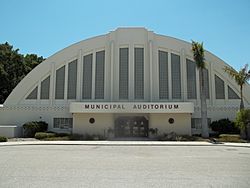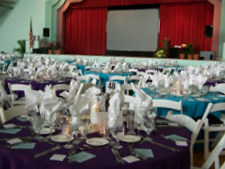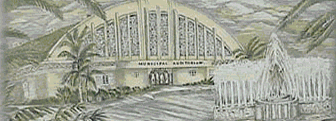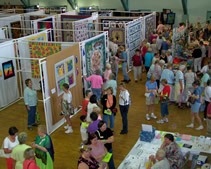Sarasota Municipal Auditorium facts for kids
Quick facts for kids Sarasota Municipal Auditorium |
|
|---|---|

Front of Municipal Auditorium
|
|
| Alternative names |
|
| General information | |
| Type | Municipal auditorium |
| Architectural style | Art Deco and Moderne |
| Address | 801 Tamiami Trail North |
| Town or city | Sarasota, Florida |
| Country | United States |
| Coordinates | 27°20′35″N 82°32′52″W / 27.34306°N 82.54778°W |
| Construction started | July 1937 |
| Opened | February 24, 1938 |
| Renovated | 1997 |
| Cost | $131,000 ($1.97 million in 2021 dollars) |
| Owner | Sarasota |
| Height | 39 ft (12 m) |
| Technical details | |
| Floor count | 2 |
| Floor area | 10,000 sq ft (930 m2) |
| Design and construction | |
| Architect |
|
| Engineer | Freeman H. Horton |
|
Municipal Auditorium–Recreation Club
|
|
| Lua error in Module:Location_map at line 420: attempt to index field 'wikibase' (a nil value). | |
| NRHP reference No. | 95000164 |
| Added to NRHP | February 24, 1995 |
The Sarasota Municipal Auditorium, listed in the National Register as Municipal Auditorium-Recreation Club, is a historic multi-purpose facility built in 1938. It is located at 801 Tamiami Trail North and owned/operated by the municipal government of Sarasota, Florida. The auditorium has 10,000 square feet (930 m2) of exhibit space on its main floor and also contains an Art Deco style stage measuring 1,500 square feet (140 m2).
The auditorium has been used for many community functions and recreational activities. It has also been known as the Sarasota Exhibition Hall and the Sarasota Civic Center Exhibition Hall. The auditorium is located on a large parcel of public land that is reserved for civic, government uses. On February 24, 1995, the complex was added to the U.S. National Register of Historic Places.
History
The concept of a bayfront park and municipal auditorium for Sarasota was first conceived in 1935. The Municipal Auditorium/Recreation Club was constructed as part of an 11-acre (4.5 ha) recreational complex, originally called the Civic Center or Bayfront Park. During 1936, the municipal government obtained the 37-acre (15 ha) parcel from a private company that owed $15,000 in taxes on the site. Citizens, politicians, and city employees began the effort to secure a federal Work Projects Administration (WPA) Grant for the center. In one instance, a group of prominent businessmen in Sarasota came together in March 1937 and agreed to loan the city $10,000 towards the auditorium project. These businessmen included Benton W. Powell, publisher of the Sarasota Tribune and President of the Palmer National Bank; Samuel W. Gumpertz, senior vice president and general manager of Ringling Bros. and Barnum & Bailey Circus; J. J. Williams Jr., City Attorney; Ralph Caples, a railroad and advertising executive; George Thacker, President of the Chamber of Commerce; Frank Logan, a building contractor who was serving as a fiscal Agent of the City in connection with bond refunding; and George D. Lindsay, founder, owner, and editor of the Sarasota Herald.
The federal government granted the sum of $131,000, equivalent to $1.97 million in 2021 , toward the project and work began in July 1937. Skilled labor was paid for by the municipal general fund and common labor was paid for by the WPA. Several local business and civic leaders donated funds to the construction as well. At the time of its planning the Sarasota mayor, E. A. Smith, announced plans to construct "one of the finest recreation centers in the South" on the public property.
The auditorium opened on February 24, 1938 hosting an annual Sara de Soto Celebration sponsored by the Sarasota Chapter of the Daughters of the American Revolution (DAR). Three thousand attended the celebration.
The building was designed in the Art Deco and Moderne styles by Chicago architects, Thomas Reed Martin and Clarence A. Martin. Freeman H. Horton was the engineer for the project and designed the truss system that supports the barrel-vaulted roof. Horton also collaborated with Thomas Reed Martin on recreational structures such as boathouses, pools, landscaping, and walkways. When the auditorium was constructed, the property had waterfront access to Sarasota Bay and boating was a significant activity from the recreation center. Later, dredge and fill extended the shoreline farther westward.
A second floor to the recreation club was added in 1940 at the western end of the auditorium. Ida and John Chidsey donated funding for the construction of the second floor addition. The portion of the facility contained a lounge area, a recreation room, and a card room. The recreation center was dedicated in January 1940. North of the building, facilities for shuffleboard, lawn bowling, and tennis were built.
During World War II, the auditorium served as the Army and Navy Club and was the preferred venue for hosted dances, graduations, and concerts. The Florida West Coast Symphony (now the Sarasota Orchestra) performed in the facility from its inception in 1949 until the 1969 opening of the Van Wezel Performing Arts Hall that was constructed at the bay front of the same large public parcel.
Description
The building has a barrel vaulted roof. The structure contains an amount of glass block in its eastern elevation that provides natural lighting for the interior of the large building. Typically, the design of the auditorium is described as Moderne and Art Deco, but elements of the design also suggest the International Style that is associated with the Bauhaus.
The solid hardwood maple floor in the building contributes to the atmosphere, acoustics, and comfort for all attending events, dances, and concerts.
It is a site that is used by more than 100,000 visitors a year as they attend banquets, charrettes for long-range planning, civic meetings, concerts, dances, events for teenagers, fund raising events, health lectures, homecoming events, political forums, proms and galas, training seminars, and wedding receptions.
The venue also provides access to educational programs, entertainment, exhibits, recreation, and shows. Several days are booked most weeks for exhibits and shows that support antique sales, art exhibits, auctions, coin shows, conventions, flea markets, flower and gardening shows, gem and jewelry shows, seminars, and stamp collection and sales exhibits.
Hazzard Fountain
In 1940, an electrically-illuminated fountain was donated to the Municipal Auditorium by R.P. Hazzard. The fountain was designed by Frank Martin, whose father, Thomas, designed the auditorium. Louis Larsen built the Hazzard Fountain. The fountain was declared the "crown jewel" of the complex.
The Hazzard Fountain has been moved several times and placed in a variety of settings. Due to the widening of Tamiami Trail, the fountain was removed from its original location, stored for years, and then placed at the entrance to the John and Mable Ringling Museum of Art during the late 1970s. After a few years, it was removed and placed in storage again. In 1995, the fountain was moved one last time back to its original location at the auditorium. The re-dedication of the fountain was held on January 6, 1996 at the Municipal Auditorium.
Historical renovation
The building had been renovated during the 1970s and many of the historic features were hidden by more modern features designed by the Sarasota School architect, Jack West. The front façade was covered over and a large canopy installed to extend beyond the sidewalk in front of the building. The glass blocks were covered. Numerous changes to the interior were made that later were reversed in an extensive restoration of the interior of the building.
During the 1980s a historic preservationist working for the city purchasing director Bob Gerkin, whose department oversaw the hall, pressed for the listing of the building in the national register. After being won over, Gerkin even encouraged an effort to fund the restoration of the building to its original state. Under the direction of local architects and planners, restoration work by local builders began in 1992. The building was restored to its 1937 condition under the direction of architects, Gary B. Hoyt and Jeff Hole. On October 13, 1994 the municipal government sponsored a gala and dinner dance to raise funds for the restoration and to celebrate the re-dedication of the building. Profits from the donations went to the restoration.
Funding for the major historic restoration of the building was achieved through a combination of governmental efforts that included the state Bureau of Historic Preservation, the Historic Preservation Advisory Council, and the municipal government of Sarasota. Many volunteers donated work on the restoration planning and many citizens attended planning sessions. The Municipal Auditorium was placed on the National Register of Historic Places on February 24, 1995. The complex is cited for historic designation on several levels. Foremost among them, because of its architecture and engineering features, as well as for its use as an auditorium. Entertainment and recreation, along with community planning and development are aspects cited as its area of historical significance in the community. The importance of its historic uses as a public auditorium and for outdoor and indoor recreation, therefore, are cited as significant for its designation, as well as the more typical architectural and engineering features of most designations.
The renovation work was completed in 1997. The interior of the building was restored carefully and stands as an example of dedicated restoration efforts. The distinctive glass blocks not only were uncovered, but were reinforced with building techniques not in existence at the time of the original construction. The exterior was returned to its original status as well and may be compared closely to historic postcards and photographs of the building produced shortly after its opening.
Gallery







